Herwart Siegfried Opitz
Herwart Siegfried Opitz was a former professor and rector of RWTH Aachen University. He headed the Machine Tool Laboratory (WZL) of the RWTH Aachen University from April 1936 to April 1946 and from March 1948 to October 1973. 1,2,3 Opitz is considered one of the pioneers of the scientific success of the WZL, and his decades of leadership have shaped its working style and focus to this day. 4 As a memorial to him, a bust of him stands in the main building of the WZL. Despite his achievement, his involvement in the system apparatus of the National Socialists must not be disregarded under any circumstances. Opitz was a member of the NSDAP, the SA and deputy of the lecturers Association (“Dozentenbund”). Whether he pursued these memberships out of political conviction or to improve his career options can no longer be reconstructed from today’s sources. As he also did not show any signs of resistance against the system, his denazification by the Allies and the reinstatement as head of the WZL are questionable from today’s perspective. His participation in the National Socialist committees was not publicly addressed by himself or the university for a long time.
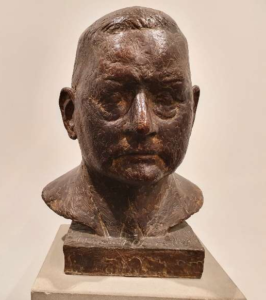
Bust in the WZL
AStA RWTH
This article concerns the career of Herwart Opitz, his role in the WZL and the RWTH, his involvement in National Socialism as well as his role in the reappraisal and commemorative culture of the RWTH. The aim is to understand why his involvement in the Nazi system was kept concealed for so long, both by him and the university. At the same time, it asks the question how such a bust should be dealt with today. Understanding Herwart Opitz as an individual poses a number of difficult challenges for observers, such as the need for a source-based reappraisal and a political value judgment from today’s perspective, or the weighing of individual guilt in a system that was upheld and supported by its followers.
So how can Herwart Opitz’s commitment during the Nazi regime be assessed from today’s sources? What conclusions can be drawn about his personal political convictions? This is a question of both historically correct reappraisal, which must be based on the available sources, and the difficult question of how such a legacy can and should be evaluated today. How should monuments, such as the Opitz bust in the WZL or correspondingly named lecture halls, be dealt with today?
A brief chronological outline:
Herwart Opitz was born in Wuppertal in 1905. His scientific career began in 1925 at the Technical University of Munich. In 1928, he passed his diploma examination at the Technische Hochschule Berlin and moved to the WZL in October 1928 as an assistant to Adolf Wallich (then director of the WZL). He received his doctorate there in 1930 with a thesis on the machinability of free-cutting steel. 5
In April 1933, Herwart Opitz joined the NSDAP and the “Sturmabteilung” (SA). 6 In April 1934, Opitz took the position as chief engineer at the WZL, subsequently received his habilitation and in 1936 succeeded Wallich as director of the WZL. .7,8 In the SA, Opitz was promoted to “Sturmmann” in 1938. This is comparable to the rank of “Private” (“Gefreiter”) in the German Army. 9 During the closure of the RWTH, Opitz held the office of deputy leader of the lecturers’ association.10
As the war ended, Opitz had to undergo a denazification procedure by the Allies. In April 1946 he is dismissed from teaching and in December 1947 he received a classification notice, which certifies his complicity. As a result, he is dismissed from the university service and was denied any financial support. Nevertheless, in a renewed opening of the proceedings – to which he was not legally entitled – he received a denazification notice on March 3, 1948, which allowed him to return to the university. As a result, Opitz was reinstated by the RWTH. In the next years of his work, Opitz laid the foundations for the present-day work of the WZL.11 Under his leadership, the Aachen Machine Tool Colloquium (AWK) was held for the first time. 12 In 1958/59 and 1967-1969 Opitz is the principal of the RWTH. 13 In 1973, Herwart Opitz becomes professor emeritus. 14
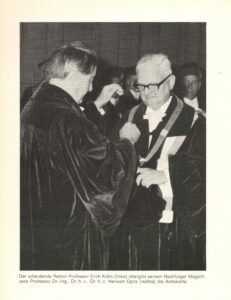
Transfer of the chain of office
HArch Aachen, AMA, 1968, S.22.
image rights: Foto-Preim , Aachen
Opitz’s involvement in the Nazi apparatus and (co-)guilt for National Socialist crimes:
Assessing Herwart Opitz’s role in the Nazi system and evaluating his personal guilt is made difficult by incomplete sources. On the one hand, there is evidence of his membership in numerous Nazi organizations, but on the other hand, there is a lack of testimony regarding his personal behavior and ideological stance.
Opitz was a member of the NSDAP, but there is a lack of sources to determine what exactly motivated his entry or his political convictions. The possibilities here range from ideological conviction to opportunism regarding his own scientific career.15 In addition to convinced supporters of National Socialism, many opportunists also joined the NSDAP in order to be able to continue their scientific or economic careers. In the period after 1933, people became members in such numbers that the admission was stopped. Those who were already committed to National Socialism in the period before the seizure of power in January 1933 were only a small minority compared to the party members who only joined under the impression of political success. 16
In November 1933, about half a year before he began his work at the WZL, he joined the SA. At this time, the SA is a party militia that uses terror and violence against its own population to enforce the political goals of the NSDAP. As a result of internal power struggles however, the SA loses most of its importance in 1934. It was ousted from key political positions and replaced by Himmler’s SS. From then on, the SA played only a subordinate role in Nazi rule. It lost almost half of its members, 1.9 million, in the period from June 1934 to September 1934. 17,18 “The numerically decimated SA [founded in June 1934] in particular as a military sports organization and veterans’ association, and during the Second World War […] [it] assumes auxiliary functions for the Wehrmacht.” 19 (translated from German) As Opitz moves into a free enterprise job, he also wants to pause his membership in the SA. He justified his deferral by claiming that he no longer works for the RWTH but is now in a free enterprise position and doesn’t have time to commit to both. and his request was granted. From today’s perspective, it is no longer possible to reconstruct what Opitz’s duties in the SA were, and in particular whether the reason for his leave of absence was valid. 20 As head of the WZL, he rejoins the SA and is promoted to “Sturmmann”.21 This promotion was given to all members who had been members for more than 6 months and could demonstrate basic skills.22 This is comparable to the rank of “Private” (“Gefreiter”) in the German army. 23
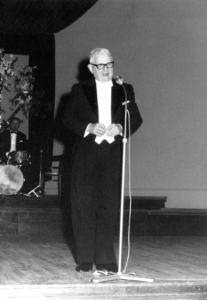
Opitz during a speech
HArch Aachen, 3.2.8_ai
In addition to the party organization memberships listed above, Opitz also completed a mandatory 10-day workshop and then attended a course at the Lecturer’s Academy (Dozentenakademie). This is one of the requirements for obtaining the Habilitation. The evaluation of these events also has an influence on the ongoing career options of the participants. They needed a positive evaluation in order to be sworn in as a civil servant. Herwart Opitz received a very positive evaluation.24,25 This makes it clear that an academic career under Nazi rule was tied to very specific conditions. Anyone who wanted to be successful had to participate in the Nazi social order one way or another.
During the closure of the RWTH due to the war, Opitz held the office of deputy of the Lecturers Association.26 According to the understanding at the time, the Lectures Association is “the front line of the movement and is responsible for the permeation of the national Socialist spirit in all aspects of university life” (translated form German)27, as the 1939/40 course catalogue describes it. It is not possible to reconstruct what tasks Opitz fulfilled during that time. Nevertheless, such an office was not absolutely necessary for career reasons and can thus be evaluated as a “determined political commitment,” (translated from German)28 especially since this organization was intended for purely ideological dissemination. Historically, however, this may not necessarily have been the case, as Ulrich Kalkmann writes: “A generalizing conclusion according to which the assumption of an office in the Dozentenbund proves the person in question to be an active National Socialist does not apply […].” 29(translated from German)
As head of the WZL, he geared its tasks to the needs of the war. He cooperates with government clients, researches fields relevant to re-armament, and receives funding from the “Reich Research Council”, among others. Through his membership in the above-mentioned various Nazi organizations, he ensured the continued existence of the WZL and the possibility to continue working and researching.30 In addition, Opitz and the WZL were significantly involved in armament research. In 1943, for example, he is appointed head of Working Group M in the main committee for armored vehicles and tractors. 31 The WZL was so critical for armaments and war that Opitz is considered indispensable at the beginning of the war. He insists on the same indispensability for his employees so that they are not conscripted into the army.32 This “protection” from wartime deployment can hardly be regarded as an act of charity toward his employees nor as resistance to National Socialism. The WZL was particularly concerned with armaments research. The indispensability of its employees was therefore essential for the preservation of armaments research at the WZL, which was a high priority for the National Socialist leadership. This was probably less a matter of special commitment to his employees and rather a way to secure his own position and his own research as well as supporting the Nazi military forces.
In her dissertation, Cornelia Kompe lists statements by contemporary witnesses who report that Opitz forbid the wearing of a uniform or expressing oneself politically. Ulrich Kalkmann considers such a ban “virtually unenforceable in the Third Reich,” (translated from German) because many of Opitz’s colleagues were also members of the SA and NSDAP.33 He suspects expedience behind the ban. There are no other sources for this behavior. Therefore, an evaluation as a political statement cannot be definitively ruled out but must be viewed with the greatest caution.
The denazification procedure of Opitz is also debatable. Opitz was classified as an accomplice and subsequently dismissed. He received no financial support and has no right to object to this verdict. Even though this had been a final verdict, Opitz is tries to get his case reopened by any means necessary, such as a special decree from the Minister of Social Affairs of North Rhine-Westphalia. According to Krebs and Tschacher, Opitz also presented a fake KPD membership in order to win this case. 34 After being rejected twice by the military government, he achieved his goal. He received a certificate of exoneration and is thus allowed to teach at RWTH again. However, this decision must be seen in the context of the political situation at the time. The Western Allies feared the loss of important key figures and highly qualified scientists to the Soviet Union in the beginning East-West conflict. In German society and the new political leadership, there was little need for a complete reappraisal of the Nazi era. The crimes committed were not investigated, and only rarely were individual perpetrators convicted. Opitz was supported by all political parties and the trade unions.35 His memberships in the National Socialist committees were at least for his denazification procedure “minderbelast[…][end]”36“minimally incriminating” (translated from German. By tampering his curriculum vitae with an alleged KPD membership, Herwart Opitz was guilty of covering up his past. It can be assumed that Opitz was aware of the seriousness of his entanglements and tried to relativize his memberships in the aforementioned organizations by faking a communist party affiliation. Opitz thus received his classification notice not because of his lack of involvement in the power apparatus of National Socialism, but despite it.
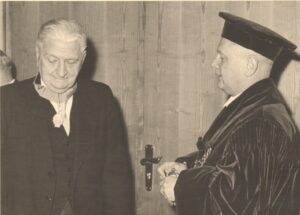
Opitz (r.) with the former rector
HArch Aachen, 1.3.1_Kra 1
All in all, according to today’s sources, Herwart Opitz was at least an accessory to the system. As a member of the NSDAP and SA, he supported the Nazi regime, although probably not in a central position. He worked with his institute on armaments research for the National Socialists. Certainly, Opitz’s involvement in the Lectures Association goes beyond that of a mere accessory. Even his denazification cannot hide this fact since it was decisively influenced by political circumstances and not by a consideration of guilt.
However, there is no evidence that he was complicit in specific crimes. Nor is there any evidence of Opitz’s personal ideological convictions. Only his falsified KPD membership testifies to a criminal initiative of his own, if only to conceal his own entanglements.
A variety of motives for Opitz’s actions are conceivable. Not every NSDAP and SA member was also a convinced follower of Nazi ideology, which is why the exact intentions of the respective person can hardly be reconstructed from membership alone. 37 Many people joined the Nazi organizations for opportunistic reasons and participated in the regime in order to be able to continue their careers. This was especially widespread in academia. At the same time, however, it was also the many opportunistic, supposedly insignificant followers who provided significant support for the system. In historical scholarship, it is precisely the importance of such hangers-on that is emphasized, without whom a totalitarian system would not be possible in this way. 38 Even where personal motives were understandable from the perspective of the time, participation in the Nazi regime can and must be criticized and condemned today. If Opitz was not a convinced follower of the Nazi ideology, he did not evade this system and did not actively resist it.
Opitz’s role in public memory and today’s treatment of his legacy:
Against the background of this difficult overall situation, the question arises why a bust of Herwart Opitz still stands in the WZL today. The RWTH and especially the WZL owed him many successes in terms of their research, development and notoriety. This is contrasted with his involvement in various aspects of Nazi rule.
For a long time, the involvement of the RWTH and its university staff in National Socialism was largely concealed. In their essay “Vom Heldenkult zur Skandalbewältigung,” (From Veteran Cult to Scandal Management) modern historians Werner Tschacher and Stefan Krebs highlight especially the handling of Herwart Opitz and Walter Rogowski. 39 For a long time, the RWTH kept quiet about the past of these two professors and only addressed their positive scientific achievements.
During the years of his work, Opitz laid the foundations for the WZL’s current work. Under his influence, the research of the WZL became more market and future oriented. Following in the footsteps of his predecessor Wallich, he established contacts in the regional economy in the period after World War II. 40 With the Aachen Machine Tool Colloquium (AWK), he creates “one of the most important congress events in production technology” 41 and thus a platform for networking with industry in the difficult post-war years.
Herwart Opitz establishes the “everything under one roof” organizational structure at the WZL, which still exists today. Through this organization, all problems that arise in a company working with machine tools can be solved at the WZL. This holistic approach was innovative and leading at that time. Even today, four departments work under one roof at the WZL.42 The principle of industry proximity and the all-encompassing approach to the problems, made the WZL an excellent training center. 43 Even today, the WZL operates in this unique style established by Opitz. They emphasize, for example, the “practice-oriented training” and the use of the “entire field of production technology “in one house” principle”.44
For a long time, these achievements were almost the only information about Herwart Opitz’s past. Due to a deliberate “non-memory”, the past of university members under National Socialism was lost.45This concealment was not an isolated case in the period after World War II. 46 However, an appropriate culture of remembrance also includes a differentiated examination of one’s own history.
Although Opitz’s denazification notice formally provided the opportunity to hide his involvement, it must be viewed extremely critically from today’s perspective. After all, the Allies preferred the social reintegration of the “Mittelbau”(middle level of administration) of the Nazi regime to a complete investigation and prosecution of all members of the apparatus, thus enabling even genuine National Socialists to reintegrate into the “denazified” postwar world. 47 Neither under the Allies nor in the newly founded Federal Republic of Germany was any interest in a full reappraisal of the Nazi period and the part played by individuals, especially successful and system-supporting personalities. Scientific significance counted more than the denazification of the RWTH. From today’s perspective, it is difficult to understand how someone with such an obscure past under National Socialism could again be granted a teaching license and thus a leading position at one of the most important technical universities in the country.
Since the 2000s, RWTH has made greater efforts to come to terms with its past. 48 In doing so, it is caught in the tension between closing the gaps that have existed for a long time with regard to its own Nazi past, but also not ignoring the successes of the RWTH and the individuals involved, such as Herwart Opitz. Such a historically differentiated view is important in order to understand why the university, as well as most of the German post-war society, remained inactive for a long time and did not push for a clarification of its past. From today’s perspective, such concealment is no longer appropriate for a differentiated culture of remembrance. In this sense, the way the institution RWTH as well as the WZL deal with the legacy of the person Herwart Opitz serves as an example of the mistakes, omissions, and systematic concealment of their own involvement in National Socialism. For the self-image of the university, it is important to remember its mistakes as well as its scientific achievements, in order not to live in a “culture of memory suppression”.49 Rather, it must be pointed out that scientific success and Nazi crimes cannot be weighed against each other and that it is part of Germany’s and the RWTH’s historical responsibility to do justice to its own heritage. The fact that the RWTH is not an isolated case, but rather characteristic of the entire West German post-war society, illustrates once again the deficits that the German remembrance culture of the Nazi era still shows today. 50
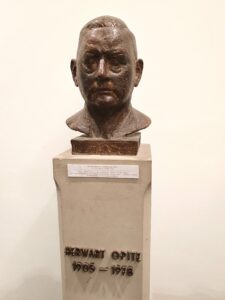
The statue in the WZL
AStA RWTH
From this perspective, it is therefore not surprising that the bust is the subject of controversial discussions. In dealing with this bust, questions arise about how society deals with the legacy of National Socialism that we neither want nor can answer at this point.
(mb,sh,sp)
Literature:
Aachen, H. d. (no date). Biographische Datenbank der RWTH Aachen. Accessed on the 5th January 2021 von http://www.archiv.rwth-aachen.de/biographischedatenbank/
Broszat, Martin (1986), Der Staat Hitlers. Grundlegung und Entwicklung seiner inneren Verfassung, München.
Das WZL über sich. (no date). Accessed on the 23th November 2020 von https://www.wzl.rwth-aachen.de/cms/WZL/Das-WZL/Profil/~ceexv/Ueber-uns/
Herbert, Ulrich (2015), Holocaust-Forschung in Deutschland: Geschichte und Perspektiven einer schwierigen Disziplin, in: Frank Bajohr, Andrea Löw: Der Holocaust. Ergebnisse und neue Fragen der Forschung, Frankfurt a.M., S. 31-82.
Kalkmann, U. (2003). Die Technische Hochschule Aachen im dritten Reich (1933-1945). Aachen: Wissenschaftsverlag Mainz GmbH Aachen.
Kater, M. (1981). Die nationalsozialistische Machtergreifung an den deutschen Hochschulen. Zum politischen Verhalten akademischer Lehrer bis 1939, in H.-J. Vogel et. al. (Hrsg.): Die Freiheit des Anderen. Festschrift für Martin Hirsch, Baden-Baden
Kompe, C. (2009). Zwischen Wissenschaft und Industrie – Mechanismen des Wissens- und Technologietransfers am Aachener Werkzeugmaschinenlabor von 1906 bis 2006. DIssertation. Aachen: Hochschularchiv der RWTH Aachen. Accessed on the 12th March 2015
Krebs/Tschacher 2, (2006). Einige Anmerkungen zum biographischen Forschungsprojekt „Die Erinnerungskultur der RWTH Aachen und das Erbe der Vergangenheit“. Accessed on the 30th January 2021 von http://www.archiv.rwth-aachen.de/wp-content/uploads/2012/03/Erinnerungskultur.pdf
Krebs/Tschacher, S. W. (2009). Vom Heldenkult zur Skandalbewältigung: Überlegungen zur akademischen Erinnerungskultur der RWTH Aachen 2009. Hochschularchiv der RWTH Aachen. Accessed on the 12th March 2015
Lumsden, R. (2000). A Collector’s Guide To: The Waffen–SS. . Ian Allan Publishing.
Rückblick des AWK. (kein Datum). Accessed on the 25th November 2020 von https://www.awk-aachen.com/rueckblick/
Stein, G. (1984). The Waffen-SS: Hitler’s Elite Guard at War 1939–1945. Cornell University Press.
References:
1Cornelia Kompe, „Zwischen Wissenschaft und Industrie Mechanismen des Wissens- und Technologietransfers am Aachener Werkzeugmaschinenlabor von 1906 bis 2006“, S. 92 & 168
2Kompe, S. 128f
3http://www.archiv.rwth-aachen.de/biographischedatenbank/ zuletzt aufgerufen am 05.01.2020
4Kompe, S 198ff
5Kompe, S 87f
6Kompe, S. 88 und 107
7Kompe, S. 88ff
8Stefan Krebs und Werner Tschacher, „Vom Heldenkult zur Skandalbewältigung“, S. 221
9Stein, S.297
10Kompe, S. 109
11Kompe, S. 151
12Kompe, S. 132f
13http://www.archiv.rwth-aachen.de/biographischedatenbank/ zuletzt aufgerufen am 05.01.2020
14Kompe, S. 167
15Kompe, S. 88 und 107
16Falter, S.475
17Hier folgt eine weitere Einordnung der SA, die wir nachreichen werden.
18Petter, S.569f
19Kompe, S. 108
20Kompe ,S. 107f
21Kompe, S. 109
22Lumsden, S. 109
23Stein, S.297
24Kompe, S. 88ff
25KaterS. 49-75
26Kalkmann, S. 424
27Tschacher/Krebs, S.221 Fußnote 136 ein Zitat aus dem Vorlesungsverzeichnis 1939/40
28Kompe, S. 109
29Kalkmann, S. 61
30Kompe, S. 197
31Kompe, S. 118
32Kompe, S. 112
33Kalkmann, S. 408 Fußnote 1
34Krebs/Tschacher, S. 222
35Kompe, S. 128ff
36Krebs/Tschacher 2, S. 7
37Falter, S.484f
38Die Frage, wie das NS-System sich erhalten konnte und vom wem es konkret getragen wurde, ist in der Geschichtswissenschaft vielfach diskutiert worden. Dabei entwickelte sich zunehmend ein Verständnis, das weniger die einzelnen Hauptschuldigen, als vielmehr die Bedeutung weiter Teile der Gesellschaft als Mitläufer und indirekte Träger des Systems betont. Für einen knappen Forschungsüberblick zu diesem Thema vgl. Herbert, Forschungsüberblick, S.44; Beispielhaft für diese Forschungsrichtung vgl. Broszart, Der Staat Hitlers.
39Tschacher/Krebs, „Vom Heldenkult bis zur Skandalbewältigung“ S.221
40Kompe, S.151
41https://www.awk-aachen.com/rueckblick/ zuletzt abgerufen am 23.11.2020 13:00 Uhr
42Kompe, S. 153ff
43Kompe, S.152
44https://www.wzl.rwth-aachen.de/cms/WZL/Das-WZL/Profil/~ceexv/Ueber-uns/ zuletzt abgerufen am 23.11.13:00 Uhr
45Tschacher/Krebs, S.221
46Kreis/Tschacher 2, S.8
47Wolfrum, 2. Absatz
48Krebs/Tschacher, S. 226
49Krebs/Tschacher S. 221f
50Kreis/Tschacher 2 S.8